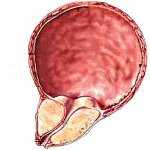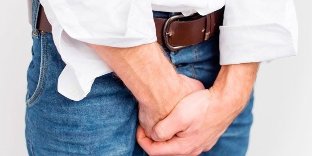Acute prostatitis – an infectious-inflammatory defeat of the prostate gland, accompanied by swelling and the formation of suppurating foci in the tissues of the prostate. Manifestations of acute inflammation of the prostate depends on the stage (catarrhal, follicular, parenchyma, abscessed) and may contain dysuric disorders, pain in the groin, fever, intoxication. Diagnosis is based on data palpation of the prostate, ULTRASOUND and Doppler studies of the prostate, warehouse, detachable urethra and prostate secretion. Treatment of acute inflammation of the prostate includes indications, antimicrobial therapy, NSAIDS, antispasmodics, analgesics, immunomodulators, physiotherapy.

Acute and chronic prostatitis are the most common and socially significant male diseases. In clinical urology prostatitis diagnosed in 30-58% of men who are in the reproductive and working age (30-50 years). During the acute inflammation of the prostate gland accompanied by disturbances of the sexual function and fertility, impaired emotional status and social disadaptation.
Causes of acute inflammation of the prostate
Representatives of the acute inflammation of the prostate mostly affects non-specific infectious agents, penetrating into the tissue of the prostate - gram-negative (escherichia coli, Klebsiella, Proteus) or gram-positive (Staphylococci, enterococci, streptococci)
Often of acute prostatitis may appoint representatives of urogenital infections:
- chlamydia,
- trichomoniasis,
- ureaplasmosis,
- gonorrhea,
- mycoplasmosis,
- candida and other
Most often, the penetration of microbial substances in the tissue of the prostate occurs transcanalicular route – through the output duct of the gland, opening in the rear wall of the urethra. So the urethritis of each genesis very often complicates acute inflammation of the prostate gland. Less common microbial flora gets in the prostate from the bladder in acute cystitis. The introduction of pathogens in the gland significantly facilitated when an increase in intraurethral pressure (reprehenderat, stones urethra), the implementation of the endourethral manipulation (bougienage urethra, bladder catheterization, ureteroscopy, cystoscopy, etc.).
In addition, acute prostatitis may be the result of hematogenous penetration of the infection, helping the conditions of perfusion of the prostate with a widely developed system of arterial and inflammation of the anastomosis. In hematogenous drift of germs getting into the tissue of the prostate from the remote festering bearing in tonsillitis, sinusitis, caries, cholecystitis, bronchitis, pyoderma, etc. Maybe lymphogenous infection of the prostate from the bowel at the anal fissures, proctitis, colitis.

To non-transferable factors, which contributes to the development of acute inflammation of the prostate, include the persistent stagnation in the veins of the pelvis and the violation of the outflow of the acini of the prostate. Stagnation may appoint disritmia sexual life and sexual disorders – the practice of interrupted sexual intercourse, lack of or irregular sexual life, excessive sexual activity and other Pathological deposit of blood in the venous bloodstream of a small pelvis may indicate when a sedentary lifestyle, frequent constipation, hypothermia, chronic (especially alcohol) intoxication, of varicose veins the veins of the pelvis.
Forms of acute inflammation of the prostate
In the development of acute inflammation of the prostate issued the following forms, which are at the same time its phases:
- catarrhal,
- follicular,
- parenchyma,
- an abscessed.
Acute prostatitis begins with the catarrhal inflammation – changes of the mucous membrane and nogsliznice layer of the output ducts of individual lobules of the gland. Later swelling of the walls of the pipe supports the stagnation of the mucous-purulent secretion in the follicles of the prostate and progression of inflammation, in connection with which may develop focal suppuration of the lobes – acute follicular prostatitis. In the singular defeat of the lobules and a diffuse involvement of the parenchyma and interstitial tissue of the prostate in suppurative-inflammatory process, acute prostatitis passes into its next stage – of the parenchyma. In the case of a merger of small ulcers in the main focus of a formed abscess of the prostate, which may open into the urethra, perineum, rectum or bladder.
The symptoms of acute inflammation of the prostate
Clinical manifestations in acute inflammation of the prostate correspond to the stages of the process. Common manifestations serves as pain, disorders of urination and intoxication.
In the acute catarrhal stage of inflammation of the prostate felt the heaviness and pain in the groin. Dysuric disorders characterized by a painful increase in urination, especially at night. Body temperature is maintained within the limits of the standards, may be slightly increased; intoxication missing. In the palpation examination of the prostate is not changed or slightly increased, several painful. The study of the secretion of the prostate gland detects the increase of leukocytes, the concentration of mucous-festering thread. In the urine during the emptying of the output ducts of the acini appear leukocytes. Prostate massage, as usual, maybe because of the pain. Treatment, is being investigated in the catarrhal stage of acute inflammation of the prostate gland, leads to a recovery after 7-10 days.
The follicular form of acute inflammation of the prostate gland flows more than the right, accompanied by dull aching pain in the groin, irradiating in the penis, back passage or the sacrum. On this background, urination is painful and difficult, until the development of acute delay of urine. The act of defecation, in the acute follicular inflammation of the prostate also difficult because of the pain expression. Due to the increase in body temperature to 38°C, disturbed general condition. Palpation per rectum is determined by the enlarged, dense, hard, asymmetric prostate gland, sharply painful to the individual sections in the Paltseva study. Urine collected after abdominal palpation, contains a large number of leukocytes and purulent fibers, which form muddy precipitates. The implementation of the massage for a more of prostate secretion in the follicular phase of the acute inflammation of the prostate is contraindicated. During the energy treatment of acute follicular prostatitis can favorably resolved; otherwise, it goes to the next, the parenchymal phase.

Clinic acute parenchymatous inflammation of the prostate gland develops rapidly. It is a typical marked hyperthermia (up to 39-39,5°C and above) with chills, general weakness, oppression, appetite, thirst. Initially urination sharply learning and difficult, then may stop completely. Attempts to empty the bladder or bowel, accompanied by intense pain. Develops the excruciating tenesmus, constipation, flatulence. The pain spreads to the rectum, has a pulsating character, forcing the patient to take a forced position – lying down with pursed his feet. In the development of reactive inflammation of the rectum from the anus, excreted slime.
Palpation is determined by the diffuse enlarged, with fuzzy contours of the iron, is very painful at the slightest touch. Massage of the prostate gland in the parenchyma of the stage of acute inflammation of the prostate categorically contraindicated. Sometimes because of a severe swelling pararectal fiber and pain rectal examination cannot be done. In the urine – sharply expressed album sanguinem cellam, pyuria. The result of an acute parenchymatous inflammation of the prostate may serve to distinguish the disorders, the formation of abscess of the prostate or chronic prostatitis.
Diagnosis of acute inflammation of the prostate
Recognition and identification of the stage of acute inflammation of the prostate is held to the urologist and is based on a comprehensive physical examination, laboratory and instrumental survey. The study of the prostate through the rectum allows you to determine the size, consistency, homogeneity, symmetry of the gland; pain of the reaction, the bearings of the organisations, signs of purulent tissue breakdown. Palpation of the gland in acute inflammation of the prostate is performed very gently, without rough pressure and massaging movements. In the secret of the prostate found to increase in the number of leucocytes and amyloid taurus, reducing the amount of lecithin grains.
In acute inflammation of the prostate gland is celebrating increased leukocyturia in the third portion of urine and in the urine obtained after palpation of the prostate. To highlight the causative agent of acute inflammation of the prostate needed bacterial inoculation test of urine and detachable urethra with antibiotics, PCR research scraping, seeding of blood on the sanguinem cultura. The character and severity dysuric disorders in acute inflammation of the prostate evaluated using uroflowmetries.

ULTRASOUND of the prostate with moderate pain syndrome can be performed transrectal; in the case of the expressed pain reaction – transabdominal. Anoscopically assesses the shape, the size of the gland, the presence of focal or diffuse changes, is determined by the stage of acute inflammation of the prostate gland. The use of Doppler studies allows a detailed and differently evaluate the vascularization of the prostate.
When planning surgical tactics against the destructive forms of acute inflammation of the prostate it is advisable to perform CT or MRI of the small pelvis.
Treatment of acute inflammation of the prostate
The main role in the treatment of acute inflammation of the prostate belongs to the causal therapy. Like how is it possible an earlier designation of the antimicrobial (antibacterial, antiviral, antitrichomonal, antimycotic) drugs to suppress the multiplication of micro-organisms of the gland and tissue of the urethra. With the aim of reducing spasms and soreness urination prescribe analgesics, antispasmodics, rectal candles with Anaesthesinum or by belladonna, thermal microclysters. In the complex therapy of acute inflammation of the prostate gland are used non-steroidal antirheumatic agents, enzymes, immunomodulators, vitamins, infusion solutions.
Physiotherapy in acute inflammation of the prostate is performed after remitting acute symptomatology. With the aim of anti-inflammatory, drops, pain reliever action, improvement of microcirculation and local immunity apply rectum electrophoresis, UHF-therapy, UHF-therapy, massage of the prostate. In acute inflammation of the prostate demonstrated compliance with bed rest, sparing diet, sexual peace.
When retention of urine on the background of acute inflammation of the prostate gland avoid to perform catheterization of the urinary bladder, bias trocar cystostomy. When an abscess of the prostate arises the need for surgical aids - an autopsy and drainage cavity of the abscess.
For the cure of acute inflammation of the prostate judged for the restoration of the structure of the tissues of the gland and its function, normalize the composition of the juice of the prostate gland, the removal of pathogens that have caused inflammation, from biological fluids.
Prognosis and prevention
Typically, timely and justified causal therapy leads to cupping signs of acute inflammation of the prostate gland. Abscess of the prostate or chronic inflammation happens in more advanced cases.
Prevention of acute inflammation of the prostate should include the reorganization of the infectious foci in the body, holding the endovesical and endourethral stripping in accordance with the rules of asepsis, early treatment of sexually transmitted DISEASES and urethritis, the normalization of sexual life and physical activity.
























